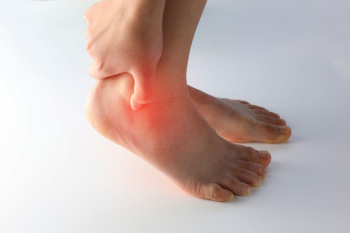
While most people associate gout with the big toe, it can also affect the ankle joint. Gout causes intense pain, swelling, and stiffness due to the buildup of uric acid crystals in the joint. When uric acid levels in the blood rise, sharp crystals may form in the ankle, which can make walking and basic activities challenging. Risk factors for gout include consuming foods high in purines, such as red meat, organ meats, and certain seafood, as well as sugary drinks and alcohol, which can elevate uric acid levels. Ankle gout may flare up unpredictably, causing severe discomfort that can last for days or even weeks. A podiatrist can help to manage gout through specific measures. Certain medications can be prescribed that reduce inflammation and changes to diet and lifestyle choices may also be suggested. If not properly managed, gout-related inflammation can lead to lasting damage to the ankle joint. If your ankle is in severe pain, it is suggested that you schedule an appointment with a podiatrist for an exam, diagnosis, and treatment.
Gout is a foot condition that requires certain treatment and care. If you are seeking treatment, contact one of our podiatrists from Barry University Foot and Ankle Institute. Our doctors will treat your foot and ankle needs.
What Is Gout?
Gout is a type of arthritis caused by a buildup of uric acid in the bloodstream. It often develops in the foot, especially the big toe area, although it can manifest in other parts of the body as well. Gout can make walking and standing very painful and is especially common in diabetics and the obese.
People typically get gout because of a poor diet. Genetic predisposition is also a factor. The children of parents who have had gout frequently have a chance of developing it themselves.
Gout can easily be identified by redness and inflammation of the big toe and the surrounding areas of the foot. Other symptoms include extreme fatigue, joint pain, and running high fevers. Sometimes corticosteroid drugs can be prescribed to treat gout, but the best way to combat this disease is to get more exercise and eat a better diet.
If you have any questions please feel free to contact our offices located in Miami, North Miami Beach, Miami Beach, and Tamarac, FL . We offer the newest diagnostic and treatment technologies for all your foot and ankle needs.
